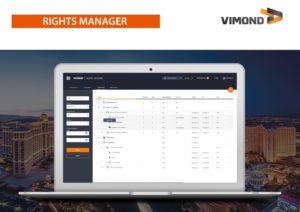Vimond Media Solutions has announced that they are launching an improved version of the Rights Manager module at NAB 2017. The program has been developed in close cooperation with broadcasters, reportedly making rights management a fully integrated part of the content management processes, and replacing the manual ad hoc tools that many broadcasters currently use.
Vimond’s goal with its Rights Manager is to organize the cumbersome and fragmented domain of contracts management into a tightly integrated, automated process. It saves time and minimizes duplication and errors, and therefore reduces the risk of legal havoc for broadcasters.
With Rights Manager, contract managers can track a contract through its full life cycle. Rights managers can stay on top of the multitude of publishing regions, countries and technical platforms. Based on the contractual rights, the license windows can be exported directly to the Content Manager, and the content and metadata ingest process can also be fully automated.
“We understand that content acquisition and rights management are a huge part of running an OTT service. We want to create closer ties to the content rights holders and provide our customers with the most compelling solution for rights management on the market,” said Glenn Pedersen, CTO Vimond Media Solutions.
New features being launched at NAB 2017 include simplifying the management of geographic regions in order to control global rights, and allowing synchronization of all content for a given region via the interface. An improved content rights scheduling workflow visualizes when content is made available, and ensures it is in line with contract restrictions. Finally, the updated content management workflow makes it easy to reuse the same content in other contracts.
The Rights Manager module provides a new workflow which simplifies content acquisition.
Until now, many broadcasters have managed their content rights in external systems, which are not integrated with the video CMS. This results in manual copying of complex data between systems, which is prone to manual error. In addition, it is difficult for rights managers to maintain a full overview over multiple dimensions such as region, country, and technical viewing platform.
“By reducing the manual steps needed to transfer rights management data between our system and third parties, we will make the process more efficient and less error-prone,” concluded Pedersen.






